Parian Ware
Affordable
Art for the Masses
by
Bob Brooke
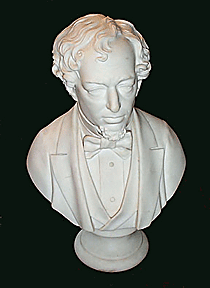 The
marble-like beauty of Parian Ware captivated Victorians. It allowed the
middle classes to possess articles of high art. And by the end of the 19th
Century, every properly furnished Victorian parlor contained at least
one piece of it. Victorians welcomed Parian’s inexpensive, small-scale
copies of busts of literary and political figures, as well as its
decorative vases, boxes and pitchers, adorning their homes with these
ornaments to show their gentility. It’s been said that Parian had the
same effect on statuary as the invention of the print to painting. The
marble-like beauty of Parian Ware captivated Victorians. It allowed the
middle classes to possess articles of high art. And by the end of the 19th
Century, every properly furnished Victorian parlor contained at least
one piece of it. Victorians welcomed Parian’s inexpensive, small-scale
copies of busts of literary and political figures, as well as its
decorative vases, boxes and pitchers, adorning their homes with these
ornaments to show their gentility. It’s been said that Parian had the
same effect on statuary as the invention of the print to painting.
Less expensive than bronze and more durable
than plaster, Parian was a development of earlier biscuit porcelain. Its
invention did not come out of thin air, however. It was a derivative of
the unglazed, white porcelain biscuit figures produced by French
factories such as Sevre. Since biscuit was a very flat and cold
porcelain, various firms and individuals attempted to find a warmer,
creamier material, more like marble from which they could mold
decorative items.
History of Parian Ware
The official catalogue of the Great
Exhibition of 1851 gives Thomas Battam credit for inventing Parian,
saying that "he succeeded in producing a very perfect imitation of
marble, both in surface and in tint." While Battam may have
invented it, several English factories claimed credit for its
development. But the Staffordshire firm operated by William Taylor
Copeland and Thomas Garrett was the first to produce and sell it in
1842, and went on to become one of its major manufacturers.
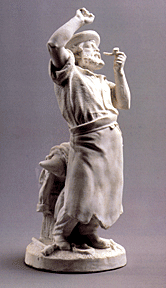 Several potteries marketed it under different
names. The Copeland firm called it "statuary porcelain"
because of its resemblance to the fine white marble of neoclassical
sculpture. Wedgwood named it "Carrara," after the Italian
quarry patronized by Michelangelo. But it was Minton which coined the
word "Parian" to suggest Paros, the Greek isle that furnished
much of the stone used in the classical period. Thus, it quickly became
the medium's generic name. Several potteries marketed it under different
names. The Copeland firm called it "statuary porcelain"
because of its resemblance to the fine white marble of neoclassical
sculpture. Wedgwood named it "Carrara," after the Italian
quarry patronized by Michelangelo. But it was Minton which coined the
word "Parian" to suggest Paros, the Greek isle that furnished
much of the stone used in the classical period. Thus, it quickly became
the medium's generic name.
Ultimately, potteries produced two varieties of
Parian ware: statuary Parian, used in the making of figures and
reproductions of sculpture, and standard, Parian, from which they made
hollowware. Statuary Parian, incorporating a glassy frit–a semi-fused
substance used to add density–was classified as soft porcelain.
Standard parian, with a greater proportion of feldspar in the
composition but no frit, was hard porcelain. The presence of iron in the
feldspar without iron silicate caused early Parian statuary to appear
ivory-tinted. Both English and American potters either obtained details
of the original formula or worked out their own, resulting in enormous
production of Parian wares on both sides of the Atlantic. Plus the
invention in 1844 of a patented machine that allowed scaled
reproductions of larger bronze or marble originals made replicas of
figures and busts by noted sculptors widely available.
The Art Union of London's order in 1846 for
Parian models of John Gibson's marble statue of Narcissus was the first
major commission of Parian statuary porcelain. The Art Unions,
subscriber services for fine art reproductions, proved crucial in
popularizing Parian ware.
Christopher Webber Fenton and his
brother-in-law Julius Norton first made Parian in America at their
pottery in Bennington, Vermont. Bennington had been a center for the
production of utilitarian salt-glazed stoneware since the early part of
the century, but Fenton and Norton seized the opportunity to expand
their horizons that the developing mechanization of the ceramics
industry offered. The arrival of John Harrison, a potter from England's
Copeland Works, in 1843, enabled Fenton, by 1846, to begin manufacturing
Parian figures that at first copied English designs. Using plaster
molds, Fenton made not only figures but also decorative ornaments that
included everything from vases decorated heavily with applied grapes,
leaves and tendrils to boxes and cologne bottles destined for the
mantles and whatnots in scores of American homes.
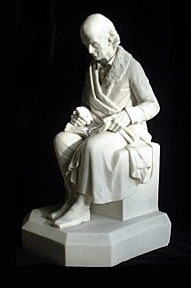 During the next two years, Norton having
abandoned the operation, Fenton used the mark "Fenton's Works;
Bennington, Vermont." When he acquired a new partner, a local
businessman named Alanson Potter Lyman, Fenton changed the factory's
name to the United States Pottery Company. During the next two years, Norton having
abandoned the operation, Fenton used the mark "Fenton's Works;
Bennington, Vermont." When he acquired a new partner, a local
businessman named Alanson Potter Lyman, Fenton changed the factory's
name to the United States Pottery Company.
Daniel Greatbach, a Staffordshire potter who
arrived in Bennington after beginning his American career in Jersey
City, New Jersey, did much of the firm’s designing. Consistent with
English counterparts of the mid-1840s through the 1850s, relief molding
on Bennington pitchers and vases usually consisted of the
naturalistically rendered plant forms of the Rococo-revival style.
Unfortunately, the factory closed in the Spring
of 1858 due to the high cost of labor, the high losses by breakage, and
the rough competition posed by cheaper imported articles. Unfortunately,
a stigma of inferiority marked the American Parian industry, for it was
generally held that imported goods, English in particular, were
inherently better, whatever their quality.
Thus, over the following 60 or so years,
England’s best known Parian makers continued to produce large numbers
of pieces. By the end of Queen Victoria’s reign, Parian ware had
declined in popularity.
Until the arrival of Parian, sculpture was
primarily the domain of royalty and the wealthy. Queen Victoria
surrounded herself with marble statues of her children and commissioned
a statue of her beloved Prince Albert attired, surprisingly, as a Roman.
And Americans often returned triumphantly from their Grand Tours of
Europe with Parian statues that spoke eloquently of their Continentally
acquired "culture."
Making Parian Ware
Potters made Parian statues by
slip-casting. They poured liquid porcelain, or slip, into a mold and
allowed it to harden enough to coat the walls of the mold. They then
poured out the excess, creating a thin-walled, hollow form.
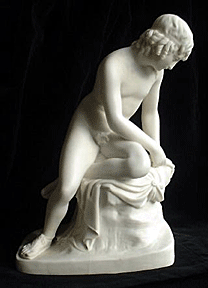 Because Parian had a higher proportion of
feldspar than porcelain, makers fired it at a lower temperature. The
increased amount of feldspar caused the finished body to be more highly
vitrified, thus possessing a color verging on ivory and having a
marble-like texture that’s smoother than that of biscuit, or unglazed,
porcelain. Potters either made relief ornamentation by hand or in a
mold. They left most Parian in its natural, creamy white state, but
applied background colors, usually shades of blue, to contrast with the
relief motifs. Because Parian had a higher proportion of
feldspar than porcelain, makers fired it at a lower temperature. The
increased amount of feldspar caused the finished body to be more highly
vitrified, thus possessing a color verging on ivory and having a
marble-like texture that’s smoother than that of biscuit, or unglazed,
porcelain. Potters either made relief ornamentation by hand or in a
mold. They left most Parian in its natural, creamy white state, but
applied background colors, usually shades of blue, to contrast with the
relief motifs.
During the 1870s and 1880s, as the Parian era
flourished and faded, potters introduced tints into the medium. Because
the matte surface of the material attracted dirt, which was difficult to
remove, makers protected much of the Parian made here and abroad with a
smear glaze, achieved by chemicals added to the kiln in much the same
way that they add salt to a kiln of stoneware. The slight sheen of the
smear glaze also preserved the Parian’s crisply molded details, which
would have blurred under a viscous finish. However, potters fully glazed
the interiors of vases and pitchers intended to hold liquids.
The exact ingredients of Parian, as well as the
firing process, varied between different manufacturers and even for
different pieces and batches by the same manufacturer producing all
sorts of variations. There’s little doubt that some of the early
Parian statuary pieces did indeed achieve the look and feel of marble.
However, others developed a color, texture, and feel which wasn’t a
replication of marble but which had its own unique characteristics. It
may have been this evolution of Parian into a unique material in its own
right which led some of the manufacturers to think about producing
non-statuary pieces in Parian.
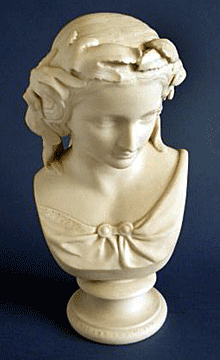 Among the most beautiful and successful wares
invented by 19th-century potters were those decorated in what came to be
known in England as pate-sur-pate, a paste-on-paste technique
devised sometime after 1870 by Marc-Louis Solon of Minton's in England.
Solon used pate-sur-pate, involving both modeling and painting
techniques, on stained Parian ware decorated with reliefs in translucent
tinted or white slip, the colors being laid one upon the other. Among the most beautiful and successful wares
invented by 19th-century potters were those decorated in what came to be
known in England as pate-sur-pate, a paste-on-paste technique
devised sometime after 1870 by Marc-Louis Solon of Minton's in England.
Solon used pate-sur-pate, involving both modeling and painting
techniques, on stained Parian ware decorated with reliefs in translucent
tinted or white slip, the colors being laid one upon the other.
In most fields of human endeavor, progress
tends to produce better results over time. This wasn’t the case with
Parian, as inferior material tended to predominate and many later
figures were poor copies of earlier high quality ones. It’s a
characteristic of Parian that it loses up to one third of its size in
firing and many later direct copies are physically smaller than the
originals. Thus, most of the finest quality pieces tend to be from the
first 30 years of Parian production.
Generally, only the major Parian makers marked
their pieces and then only their statuary. Many non-statuary pieces
weren’t marked.
"Fenton's Works;
/Bennington,/Vermont," the mark used by Fenton’s Bennington firm,
clearly identifies the pitchers made prior to 1853, the year in which
the pottery changed its name to the United States Pottery Company. The
earlier of the two is a raised or applied mark impressed "UNITED
STATES/ POTTERY CO./ BENNINGTON, VT.," which appears on four of
their pitcher patterns–Cascade, Climbing Ivy, Tulip and Sunflower, and
Paul and Virginia without figures. A raised ribbon mark with the
initials "U.S.P." was the last mark used on Parian by this
firm. The ribbon also features two numbers denoting the pattern number
and the capacity of the pitcher.
Popular Forms of Parian
A long parade of portrait busts of such
diverse notables as Shakespeare, Disraeli and Napoleon, and statuettes
of everyone from Venus to Red Riding Hood emanated from English makers
who followed their making of statuary with such other ornamental pieces
as pitchers and vases. Copeland even issued Parian figures of a black
slave to cater to the American market during Civil War years.
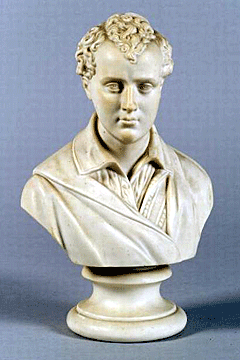 American factories issued busts of Milton,
Byron, and even Apollo, as well as figures representing Autumn, angels,
cherubs, children, animals and birds, along with copies of noted
American sculptors such as Hiram Powers' famous statue, The Greek Slave.
They made everything from three-quarter life-size busts to small heads
that capped the handles of canes and umbrellas. American factories issued busts of Milton,
Byron, and even Apollo, as well as figures representing Autumn, angels,
cherubs, children, animals and birds, along with copies of noted
American sculptors such as Hiram Powers' famous statue, The Greek Slave.
They made everything from three-quarter life-size busts to small heads
that capped the handles of canes and umbrellas.
American makers also borrowed subjects from
national sports–the baseball figures made at the Ott and Brewer
pottery by Isaac Broome, for example–or from national occupations,
such as the blacksmith executed for the Union Porcelain Works by Karl L.
H. Muller.
Victorians valued pitchers and vases of various
sizes and shapes, including those shaped like hands holding receptacles
for flowers or ears of corn or shells. Some had white relief decoration
of grapes and vines, oak leaves, or climbing roses against a blue
stippled background.
Potters at Bennington made some with blue
porcelain slip baked and fused with the white Parian. They also used
other colors, notably pink and green, which aren’t commonly found
these days.
What to Look For When Buying Parian
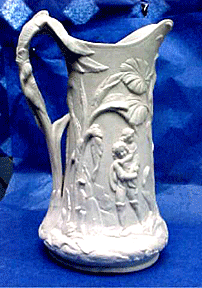 There’s a misconception that any unmarked Parian pieces from New
England had to have been made by the United States Potter Company of
Bennington. This myth seems to have originated in the 1920s with Dr.
Charles Green, a New York physician and ceramics enthusiast, who amassed
a large collection of Parian trinket boxes and vases during his
antiquing forays throughout New England. Without knowledge of imported
English ceramics into New England, he reasoned that anything found there
must have been manufactured there. Since the Bennington pottery was
known to have made some Parian, Green reasoned that all his unmarked
Parian must have been made there as well. There’s a misconception that any unmarked Parian pieces from New
England had to have been made by the United States Potter Company of
Bennington. This myth seems to have originated in the 1920s with Dr.
Charles Green, a New York physician and ceramics enthusiast, who amassed
a large collection of Parian trinket boxes and vases during his
antiquing forays throughout New England. Without knowledge of imported
English ceramics into New England, he reasoned that anything found there
must have been manufactured there. Since the Bennington pottery was
known to have made some Parian, Green reasoned that all his unmarked
Parian must have been made there as well.
It’s a known fact that English immigrant
potters brought with them a supply of English plaster casts and design
molds to use in America. A pitcher can resemble an English one so
closely as to suggest that it was cast in a mold made from the original
piece. Therefore, it can be extremely hard for a beginning collector to
tell the difference between unmarked English and American Parian Ware.
Potteries all over the British Isles produced
Parian pieces to meet the growing demand for this affordable ware.
Leading makers of it included Copeland, Minton, Worcester, Wedgwood,
Goss, and Robinson and Leadbeater. Much of the statuary came from the
work of the period’s finest artists, who approved of the fidelity of
reproductions in Parian.
Since many collectors of porcelain regard
Parian as too austere in its marble-like whiteness and not of the high
quality of pure porcelain, interest in it by dealers is low. Few dealers
on either side of the Atlantic specialize in it to any extent. Some may
have a few pieces of Parian on hand, while others sell it when they come
by it.
Some pieces may be heavily and/or poorly
restored. It’s always worth looking at what small dealers have, but
the serious collector is likely only to find acceptable pieces perhaps
one time in a hundred.
To read
more of my articles, please
visit
my Web site.
<
Back to Antiques Articles
Next Article > |
